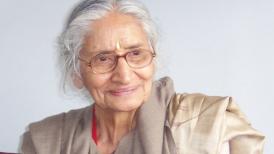Cultural Matriarch of India
Educator, institution builder, ‘grand matriarch’ of cultural research—Kapila Vatsyayan (AM ’49) was known for her intimate knowledge of Indian classical dance and her innate ability to knit literature and the arts in the aesthetic understanding of it.
The renowned scholar of art history, architecture and Indian classical dance was born in New Delhi in 1928. She was the second child to her parents Ram Lal and Satyawati. Vatsyayan’s mother, a Hindi writer, insisted on her learning dance from the age of eight. She learned Kathak, Manipuri, and Odissi, among other techniques throughout her lifetime (1928–2020).
Vatsyayan arrived in Ann Arbor to pursue her master’s degree in Education after receiving a master’s in English from Delhi University. It was here that she was exposed to modern dance techniques and literary studies, and through readings of the Upanishads and cultural philosophers like Ananda Coomaraswamy she grew to understand dance as a way of self-awareness. Upon returning to India she completed her PhD studies at Banaras Hindu University where she strengthened her foundation in Sanskrit, Indology, and archaeology. Vatsyayan authored over 200 research papers and 20 books and taught at universities in Delhi, Banaras, Philadelphia, and California during her storied career.
Her approach to the arts was markedly interdisciplinary. To arrive at her aesthetic theories of dance, she applied the study of literature, sculpture, painting, music, and theatre. Her profound interest in classical dances led her to a deep study of folk and tribal dances. She saw the classical, the folk, and the contemporary as equally valid forms of creativity and imagination. And, was able to straddle the classical and modern worlds with equal confidence. As she once said in an interview, “I did not go to modern dance from modern dance, but from tradition.”
Vatsyayan also appreciated the physicality of dance, distinguishing between the Western tradition of body awareness and the Asian tradition of transcending the body; between Western dance’s quest to soar and Asian dance’s groundedness. She once said in an interview: “I got the essence of each of these traditions without being bound by the conventions of these traditions. I became an unbounded bounded person.”
During her lifetime, Vatsyayan served as a member of parliament and bureaucrat in India and was a lifetime trustee of the Indian International Centre. She also advised several governments on education and culture, and held several posts in the Government of India and in institutions such as the Sangeet Natak Akademi and the Indira Gandhi National Centre for the Arts, of which she was the founding director.
In 1970, Vatsyayan received the Sangeet Natak Akademi Fellowship, the highest honor conferred by the Sangeet Natak Akademi, India's national academy for music, dance and drama. In 1995, she was awarded the Lalit Kala Akademi Fellowship, the highest honor in the fine arts conferred by Lalit Kala Akademi, India's national academy for fine arts; and in 2011, the Government of India bestowed upon her the Padma Vibhushan, India's second highest civilian honor.
